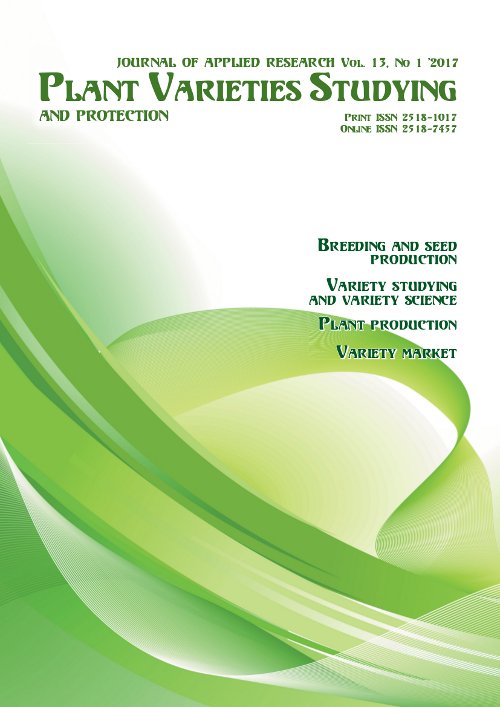Structural peculiarities of shoots of switch grass (Panicum virgatum L in the context of introduction in the Right-Bank Forest-Steppe and Polissia zones of Ukraine
DOI:
https://doi.org/10.21498/2518-1017.13.1.2017.97334Keywords:
Panicum virgatum L., introduction, shoot structure, short rhizomatous shoots, long rhizomatous shoots, reproduction budsAbstract
Purpose. To define morphological peculiarities of the different types of shoots of switch grass (Panicum virgatum L.) in the context of introduction in the Right-Bank Forest-Steppe and Polissia zones of Ukraine.
Methods. Morpho-physiological and ontogenetic analysis, morphometric technique, statistical evaluation.
Results. It was found that P. virgatum plants were producing the following types of shoots: vegetative-generative short or long rhizomatous ones (they appeared as in the underground part of a maternal shoot in «the area of shortened internodes» and in the base of its aboveground part); vegetative underground and aboveground ones (they are forming both in the axils of scales of the underground part of a maternal shoot and in the axils of cauline leaves); generative aboveground shoots (borne in the axil of cauline leaves). Morphological parameters and features of morphogenesis of reproduction, resting and secondary buds have been described.
Conclusions. During flowering phase of maternal shoot, P. virgatum reproduction buds were on the organogenesis phase I–II, their bursting occured after maternal shoot has flowered. The correlation of internodes length, leave blades and sheaths has been established. The maximum values of the above parameters were observed in the middle part of the prefloral zone of the stem. In the context of introduction, panicle earing came in the third decade of July, flowering began in the first decade of August. It was revealed that complete flowers are bloomed faster than the staminate ones.
Downloads
References
Serebryakova, T. I. (1971). Morfogenez pobegov i evolyutsiya zhiznennykh form zlakov [Morphogenesis of shoots and the evolution of grass life-forms]. Moscow: Nauka. [in Russian]
Cortese, L. M., & Bonos, S. A. (2013). Bioenergy Traits of Ten Switchgrass Populations Grown in the Northeastern/Mid-Atlantic USA. Bioenerg. Res., 6(2), 580–590. doi: 10.1007/s12155-012-9271-6
Griffiths, M. (1994). Index of Garden Plant. Portland, Oregon: Timber Press.
McLaughlin, S. B., & Kszos, L. A. (2005). Development of switchgrass Panicum virgatum as a bioenergy feedstock in the United States. Biomass and Bioenergy, 28(6), 515–535. http://dx.doi.org/10.1016/j.biombioe.2004.05.006
Rakhmetov, D. B., Verhun, O. M., & Rakhmetova, S. O. (2014). Panicum virgatum L. as a promising іntroduced species at M. M. Hryshko National Botanical Garden of the NAS of Ukraine. Introduktsiia roslyn [Plant Introduction], 3, 3–14. [in Ukrainian]
Kulyk, M. I. (2013). Impact of growing conditions on phytomass productivity of the switchgrass (Panicum virgatum L.) on the second year of vegetation. Vìsn. Poltav. derž. agrar. akad. [Bulletin of Poltava State Agrarian Academy], 2, 30–35. [in Ukrainian]
Roik, M. V., Rakhmetov, D. B., Hontarenko, S. M., Kurylo, V. L., Humentyk, M. Ya., Blium, Ya. B., … Andriushchenko, A. V. (2014). Methods of examination varieties of Panicum virgatum L. the difference, uniformity and stability. In S. O. Tkachyk (Ed.), Metodyka provedennia ekspertyzy sortiv roslyn na vidminnist, odnoridnist ta stabilnist (VOS-test). Kormovi ta koreneplidni [Methods of examination of plant varieties for distinction, uniformity and stability (VOS -test). Food and Root] (pp. 637–651). Kyiv: Nilan-LTD. [in Ukrainian]
Moroz, O. V., Smirnykh, V. M., Kurylo, V. L., Herasymenko, Yu. P., Mostovna, N. A., Horobets, A. M., & Kulyk, M. I. (2011). Switchgrass as a new phytoenergy crop. Tsukrovi buriaky [Sugar Beet], 3, 12–14. [in Ukrainian]
Zaytsev, G. N. (1991). Matematicheskiy analiz biologicheskikh dannykh [Mathematical analysis of biological data]. Moscow: Nauka. [in Russian]
Downloads
Published
How to Cite
Issue
Section
License
Copyright (c) 2017 Ukrainian Institute for Plant Variety Examination

This work is licensed under a Creative Commons Attribution-ShareAlike 4.0 International License.
Starting in 2022, the copyright to the publication remains with the authors
Our journal abides by the CREATIVE COMMONS copyright rights and permissions for open access journals.
Authors, who are published in this journal, agree to the following conditions:
- The authors reserve the right to authorship of the work and pass the first publication right of this work to the journal under the terms of a Creative Commons Attribution License, which allows others to freely distribute the published research with the obligatory reference to the authors of the original work and the first publication of the work in this journal.
- The authors have the right to conclude separate supplement agreements that relate to non-exclusive work distribution in the form in which it has been published by the journal (for example, to upload the work to the online storage of the journal or publish it as part of a monograph), provided that the reference to the first publication of the work in this journal is included.

























 Ukrainian Institute for Plant Varieties Examination
Ukrainian Institute for Plant Varieties Examination  Селекційно-генетичний інститут
Селекційно-генетичний інститут Institute of Plant Physiology and Genetics of the National Academy of Sciences of Ukraine
Institute of Plant Physiology and Genetics of the National Academy of Sciences of Ukraine
 The National Academy of Agrarian Sciences of Ukraine
The National Academy of Agrarian Sciences of Ukraine